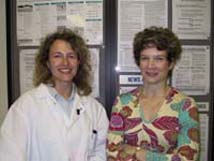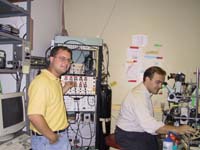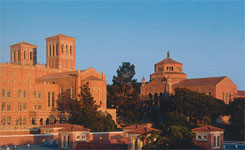
 |
 |

About the Duchenne Muscular Dystrophy Research Center at UCLA
Scientific focus of the Center
Our current understanding of the pathology of DMD indicates that there are two general approaches to the treatment or cure of DMD that offer hope. The first approach is to develop the technology for effectively reintroducing the deficient dystrophin gene, or a functional portion of it, into the dystrophic muscles using myoblast transplantation or gene therapy. However, significant technical hurdles have thus far prevented the development of therapies that rely on delivery of the dystrophin gene to DMD muscle. It is important, therefore, to develop alternative therapeutic strategies.
The second approach that may leadto treatments of DMD is to learn to slow the progress of the disease by regulating the large contribution of immune cells to the death of dystrophic muscle. Although immunosuppressants, such as prednisone, are known to slow the progress of DMD, the involvement of the immune system in the pathophysiology of DMD has been a largely neglected aspect of the disease. However, recent findings show that the immune system plays apotentiallyimportantrolein the death of dystrophic muscle. Key findings that support the contribution of the immune system to the death of dystrophic muscle are: 1) muscle fiber death in dystrophin-deficient mdx mice is reduced when specific populations of immune cells are removed from the animals prior to the onset of muscle wasting (Spencer et al., 1997, 2001; Wehling et al., 2001), and 2) specialized molecules on the surface of cytotoxic T-lymphocytes, called T-cell receptors, have a structure in DMD patients which is not found in other muscle pathologies (Gussoni et al., 1994), suggesting that there is a common molecule that "turns-on" these cells in DMD patients. Together, these observations indicate that an immune response may underlie much of the muscle cell death that occurs in dystrophin-deficient muscle. Clarification of the mechanism by which this occurs can open routes to new therapeutic treatments that may reduce the extent of muscle death in dystrophin deficiencies..
Other recent findings show that additional mechanisms exist through which cells of the immune system can kill dystrophic muscle. Cells in the immune system called macrophages can generate and release molecules called free radicals, which are capable of causing damage and death of other cell types. The onset of pathology in muscular dystrophy is characterized by invasion ofthe muscle by large numbers of macrophages (Spencer et al., 1997; Cai et al., 2000; Wehling et al., 2001)which are activated to a state in which they generate free radicals. This potential route of free radical induced killing of cells is especially important indystrophin-deficient muscular dystrophy, because dystrophic muscl
e is much more sensitive and easily killed by free radicals than healthy muscle (Rando et al., 1998). Macrophages can also play an important role in promoting musclekillingby T-lymphocytes, because they can help activate T-lymphocytes to a stage at which they actively kill.
In response to these findings, we have organized a team of investigators who have combined expertise in the pathophysiology of dystrophic muscle, muscle cell biology, and cellular and molecular immunology and who are committed to applying their diverse scientific backgrounds to understanding the role of the immune system in muscular dystrophy. Because immune regulation of muscle diseases is not an area in which formal scientific training occurs, we have built our interdisciplinary team of investigators by bringing together individuals with established expertise in subdisciplines of cellular and molecular biology that are pertinent to the goals of the Center.
How is DMD research supported at the DMDRC?
The
research of all Center Scientists is supported by federal and private sources.The National Institutes ofHealth and the Muscular DystrophyAssociation arethe major sources of support for ongoing research at the Centerthat relates to understanding therole of the immune system in muscular dystrophy, and the development of new therapeutic strategies. In addition, the Muscular Dystrophy Clinic at UCLA receives generous support from the Muscular Dystrophy Association to assist in patient care.
If you are interested in supporting research in DMD at UCLA, checks can be mailed to:
Annette Klufus
UCLA Dept. of Physiological Science
621 Young Dr. South
Los Angeles, CA 90095Please make checks to "UC Regents" and please note that your contribution is for the Duchenne Muscular Dystrophy Research Center. Contributions are tax deductible.
